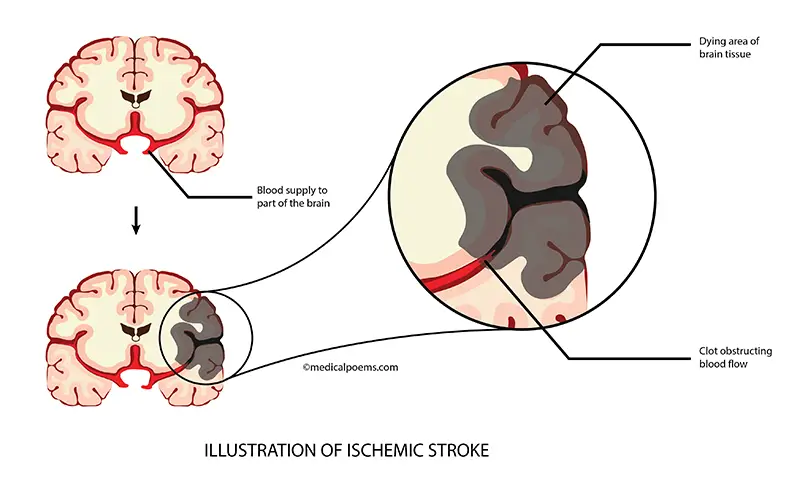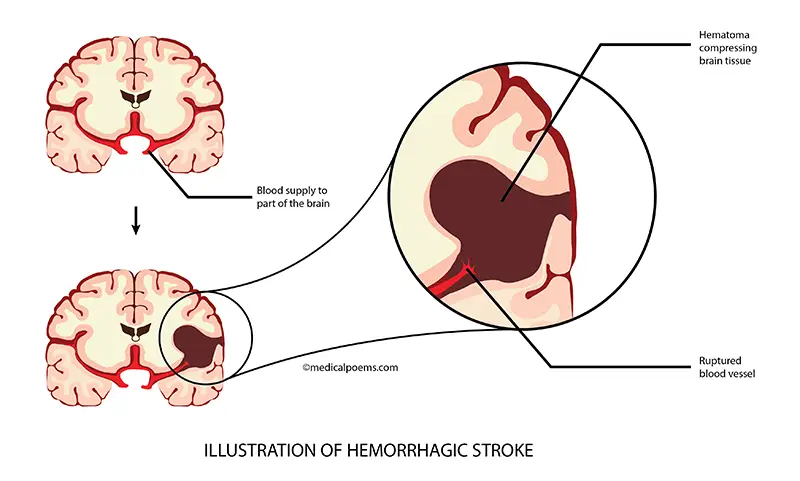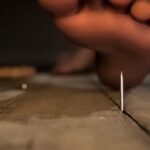Stroke is a medical condition in which brain cells (neurons) die, when the blood vessels that supply the brain, burst or become obstructed.
Other names for it, are Cerebrovascular Accident (CVA), Cerebrovascular Insult (CVI), and Brain Attack.
I prefer ‘Brain Attack’, because it is quite similar to a heart attack.
This article is in two parts; the first is a poem that ‘personalizes‘ stroke, while the second elaborates on the poem.
Press play below, for a recital/ visual representation of the ‘stroke poem’.
Stroke (Brain Attack)
There’s something about brain function;
one organ, controlling memory and emotion
Anyway, I will cause its malfunction;
those tiny neurons that act in coalition,
like bugs, I’ll see to their extermination
I could leverage on existing hypertension,
diabetes, high cholesterol, atrial fibrillation,
blood vessel disorders and malformation,
something as unusual as air pollution,
or habits begging for lifestyle modification
I particularly love blood-flow obstruction;
‘No blood’, means cell death and infarction
All I’ll do is local blood clot formation,
get a plug from elsewhere in circulation,
or take a cue, when there’s hypoperfusion
Of course, another excellent option;
bleeding, with blood accumulation
around the brain, causing compression,
as well as inflammation
Thanks to vessels tending to eruption
What’s the purpose of all the affliction,
if I don’t show symptoms or presentation
Drooping face should help recognition;
half-body paralysis, ataxia, loss of vision,
all show areas of brain affectation
I shouldn’t be telling you about prevention;
rather, I should fuel your superstition,
but this is everyday information:
Never skip your heart medication;
exercise, reduce red meat consumption
Even if symptoms appear for short duration,
seek your doctor for prompt intervention;
time is of essence for brain preservation
All this advice is against my intention
I am stroke, just another medical condition
Stroke (brain attack), explained
Stanza 1: background
There’s something about brain function; … one organ, controlling memory and emotion … Anyway, I will cause its malfunction; … those tiny neurons that act in coalition, … like bugs, I’ll see to their extermination (stanza 1)
The brain is undoubtedly the most complex organ in the body, performing functions like thought, emotion, memory, and so on.
Most of these functions involve the interaction of neurons, special cells that form the building blocks of the brain.
For neurons and other parts of the brain to stay alive and function properly, they need nourishment from blood, therefore the brain also has an extensive network of blood vessels.
There are two main categories of stroke, namely ischemic and hemorrhagic.
- Ischemic stroke: the blood supply to parts of the the brain is cut off.
- Hemorrhagic stroke: there is bleeding into the brain.
Terms like “silent”, “mini”, “thrombotic”, “embolic”, and “cryptogenic” also describe stroke.
- Silent stroke is one that does not show symptoms. Studies show that its frequency may be more than that of ‘regular stroke’.
- Mini stroke, also known as a Transient Ischemic Attack (TIA) is one in which symptoms of stroke appear for a few minutes to hours. Symptoms usually resolve within 24 hours, but there is a high probability that a full blown stroke will appear in a few months.
- Thrombotic and embolic stroke are sub-categories of hemorrhagic stroke (see below).
- Cryptogenic stroke: in 30% to 40% of cases of ischemic stroke, the cause is not known, therefore the terms “cryptogenic” or “idiopathic” suffice. Cryptogenic means ‘hidden origin’, while idiopathic means ‘unknown cause’).
Stanza 2: causes and risk factors of stroke
I could leverage on existing hypertension, … diabetes, high cholesterol, atrial fibrillation, … blood vessel disorders and malformation, … something as unusual as air pollution, … or habits begging for lifestyle modification (stanza 2)
The presence of conditions like hypertension, diabetes mellitus, and high blood cholesterol increases the likelihood of stroke.
Other risk factors, include atrial fibrillation, and kidney disease that has advanced to the point of requiring dialysis or transplant. This list also includes substance abuse (alcohol, cocaine and so on), as well as physical inactivity.
Tobacco (smoked or smokeless), as well as air pollution are also important factors that increase the likelihood of a stroke.
Smoked tobacco products like cigarettes, cigars and shisha, as well as smokeless tobacco (put into the nose or mouth), contribute to stroke by causing high blood pressure, damaging blood vessels and increasing the propensity to form clots.
Unlike smoking, which is a modifiable risk factor, air pollution is usually not so modifiable. Short-term and long-term exposure to particulate matter and gases like carbon monoxide (CO) and sulphur dioxide (SO2) from vehicles and industrial emissions, burning wood/charcoal and so on, all increase the risk of stroke (see ‘air pollution and stroke‘).
Individual blood and blood vessel disorders that lead to reduction of blood flow to areas of the brain, or tendency to rupture and bleed, are also risk factors for stroke. Examples are coagulation disorders, fibromuscular dysplasia, as so on.
Stanza 3: Ischemic stroke
I particularly love blood-flow obstruction; … ‘No blood’, means cell death and infarction … All I’ll do is local blood clot formation, … get a plug from elsewhere in circulation, … or take a cue, when there’s hypoperfusion (stanza 3)
87% of all cases of stroke, is “ischemic”.
Blood supply is vital for survival and function of all organs in the body, and the brain is no exception (see “The Circulatory System: a look into the Red Prison“).
If anything obstructs blood flow to any part of the brain for more than a few minutes, that part of the brain undergoes infarction (dies). Causes include:
- Thrombosis: ‘local blood clot’ formation, probably seeding on an area of atherosclerosis.
- Embolism: an embolus (plural = emboli) is any abnormal substance (like blood clot, clump of fat, air bubble and so on) that travels from one part of the circulation to another, and is capable of obstructing normal blood flow. Embolism is when an embolus forms a ‘plug’ to obstruct blood flow in an artery.
- Reduced blood flow (hypoperfusion) to the brain, say from a heart attack.

The doctor might try to make a distinction as to whether or not the cause of ‘ischemic stroke’ is thrombosis or embolism. In other words, the two are its subcategories.
Causes of ‘thrombotic stroke‘ include:
- Atherosclerosis affecting arteries like the internal carotid and vertebral arteries.
- Inflammatory diseases affecting the blood vessels, like Takayasu arteritis.
- Other conditions that affect the blood vessels, like fibromuscular displasia.
- Lipohyalinosis: thickening of the walls of small brain vessels due to aging and hypertension.
Causes of ‘embolic stroke‘ include:
- ‘Traveling’ blood clot from the heart, for example, in atrial fibrillation.
- Clumps of bacteria from the heart, as seen in ‘infectious endocarditis’.
- Fat traveling from a fracture, for example, hip fracture.
Stanza 4: Hemorrhagic stroke
Of course, another excellent option; … bleeding, with blood accumulation … around the brain, causing compression, … as well as inflammation … Thanks to vessels tending to eruption (stanza 4)
A little over 10% of all cases of stroke is due to hemorrhage (bleeding).
It is important to distinguish between the kind of bleeding that causes stroke and the kind that does not.
3 layers of membrane known as meninges surround the brain; the pia mater is the innermost, the arachnoid mater is next, while the dura mater is the outermost.
Two subcategories of hemorrhagic stroke occur:
- Stroke due to bleeding within the brain itself (Intracerebral hemorrhage)
- That, due to bleeding between the pia mater and arachnoid mater (subarachnoid hemorrhage).
Bleeding that occurs outside of these two ‘places’ is not generally associated with stroke. For example, subdural bleeding (between the arachnoid and dura mater), and epidural bleeding (between the dura mater and the skull).

Hypertension causes the small arteries of the brain to burst, leading to hematoma (accumulation of blood). Hematoma compresses the brain, and direct exposure of blood to brain tissue causes its inflammation, thereby damaging it.
Other causes of bleeding into and around the brain, include aneurysms (swollen blood vessels), bleeding disorders like hemophilia, etc.
Stanza 5: symptoms and presentation of stroke
What’s the purpose of all the affliction, … if I don’t show symptoms or presentation … Drooping face should help recognition; … half-body paralysis, ataxia, loss of vision, … all show areas of brain affectation (stanza 5)
Symptoms of stroke vary significantly, depending on the part of the brain that it affects, and it usually appears suddenly.
In most cases, the symptoms affect one side of the body, causing hemiparesis (weakness) or hemiplegia (paralysis).
Other symptoms include loss of vision, memory deficits, gait abnormalities, sudden severe headache (in hemorrhagic stroke) and so on.
Sudden death is also a presentation, and the commonest cause is bleeding (hemorrhagic stroke).
3 symptoms may serve as an early warning for stroke, however, they are not present in all cases:
- Facial drooping
- Arm weakness
- Speech difficulty
The first letter of each word from these symptoms, form the acronym FAS. Once you identify these symptoms, you should seek medical care immediately.
For ease, always remember “F.A.S.T“, that is, once there is sudden onset of F(facial drooping), A(arm weakness) and S(speech difficulty), then it is T(time to seek emergency care).
Stanza 6: prevention
I shouldn’t be telling you about prevention; … rather, I should fuel your superstition, … but this is everyday information: … Never skip your heart medication; … exercise, reduce red meat consumption (stanza 6)
Some of the risk factors for stroke are easier to control, than others. These “controllable” or “modifiable” risk factors are of two classes:
- Those that involve medication compliance, for example, hypertension, high blood cholesterol and atrial fibrillation.
- Those that involve lifestyle changes, like smoking, heavy alcohol consumption, illicit drug use (cocaine and amphetamines), physical inactivity and read meat consumption.
In some cases, surgery is also useful for prevention of stroke. For example, surgery to remove the build-up of fatty deposits (plaques) in the carotid artery, one of the main arteries that supply the brain.
Stanza 7: final words
Even if symptoms appear for short duration, … seek your doctor for prompt intervention; … time is of essence for brain preservation … All this advice is against my intention … I am stroke, just another medical condition (stanza 7)
Stroke may not present with symptoms, but when it does, it is important to be able to identify them and seek prompt medical care.
Transient Ischemic Attack (TIA or Mini Stroke) is a kind of stroke that usually lasts for a few minutes. Symptoms also vary, like ‘regular’ stroke (see above) and within 24 hours, ‘the person’ may be back to ‘normal’.
Once again, it is important that even though symptoms disappear within 24 hours, you should seek medical care immediately.
Conclusion
Stroke is a medical condition in which brain cells (neurons) die, usually due to poor blood flow, or bleeding.
Symptoms depend on the part of the brain affected, and may lead to sudden death.
Sometimes, symptoms may appear for no more than a few minutes, in which case it is known as a Transient Ischemic Attack or mini stroke.
Healthy life style and compliance with medications for conditions like hypertension, help to prevent stroke.




